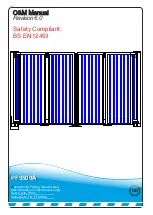
PG300 Handover Information Rev 00
Page 23 of 29
•
tripping hazards;
•
congestion;
•
Other hazards, for example: -
-
Lack of supervision;
-
Lack of training;
-
Installed on an emergency escape route;
-
Two-way traffic.
Attention is drawn to the increased risk when paddle gates are specified for two-way traffic, due
to the gate leaf potentially opening towards the user. When a significant proportion of users are
elderly, infirm, disabled or young children, additional protective devices may be needed.
Hazards during the opening cycle.
Provision should be made to deter people from occupying the swept area of the gates. If a risk
remains after the appropriate safety measures have been selected, appropriate signage should
be fitted to draw the user’s attention to the risk, e.g. “Automatic door”, “Keep clear”, “No entry”,
“Direction o
f
travel”.
Hazards during the closing cycle.
Provision should be made using one of the following means to prevent gate leaves from closing
on users during the closing cycle:
•
Speed limitation;
•
Protective devices i.e. High and low detection sensors;
•
Low energy movement;
See BS7036-0-2014 for:
•
Risk Assessment Flow Chart
•
Risk reduction process
•
Risk assessment check sheet for powered paddle leafed gates.
Additional recommendations
If powered gates are installed on an escape route and are intended as means of escape doors,
then where practicable the gates should either be capable of manual breakout in the direction
of escape or be arranged to fail safely in the open position in the event of mains power failure.
If neither of these recommendations can be achieved, or if they conflict with the advice of the
relevant fire and building control authorities, then powered gates might not be appropriate for
means of escape.
NOTE(s)
1. Attention is drawn to the Building Regulations 2010 [2], the Building (Scotland) Regulations
2004 [3], the Building Regulations (Northern Ireland) 2012 [4] and the Building Regulations
























